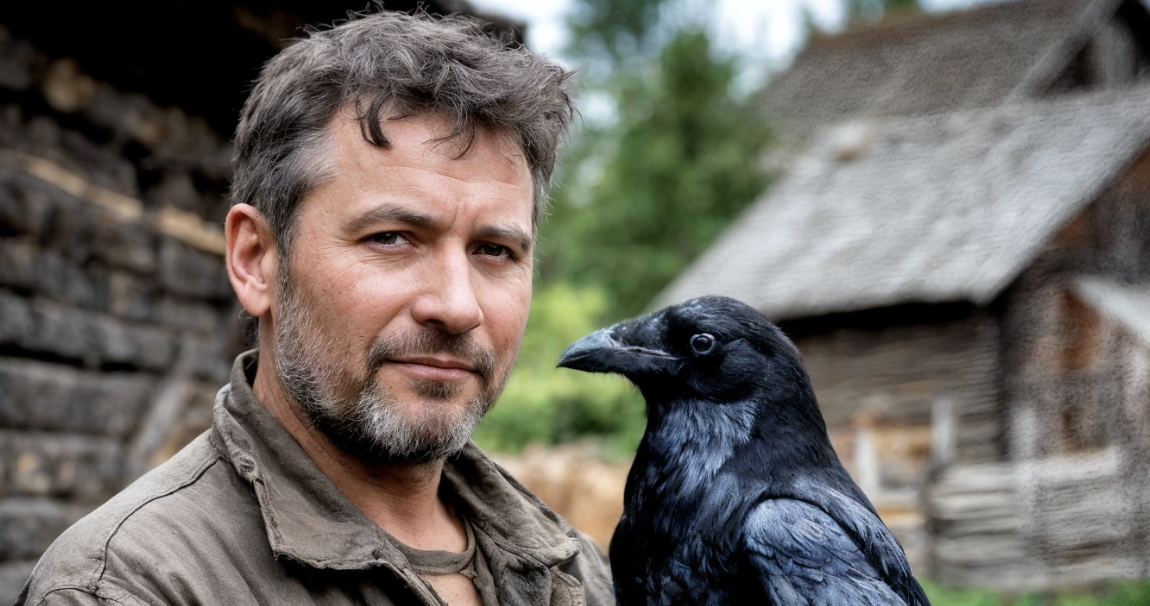On a rainy autumn evening, when the sky was covered with dense clouds and the whole world was painted in gloomy gray tones, I was walking home after an exhausting workday. Suddenly, through the sound of rain and the hum of traffic, I heard a strange, piercing cry. It stood out from the other sounds, as if someone was calling for help.
I stopped and listened. The sound came from behind some bushes near the playground. Moving closer, I saw… a crow. The bird was wet, trembling all over, and one of its wings hung unnaturally. But the most striking thing was that it was looking at me. Its black eyes were alive, full of pain and some strange hope.
“You’ve got yourself in trouble, buddy,” I whispered.
Without thinking, I took off my jacket, carefully wrapped the bird in it, and carried it home. The rain was pouring down like from a bucket, but inside me, something warmed up — it felt like this encounter was no accident.
At home, I quickly created an improvised “hospital” for it: I spread a soft cloth, set up a heating pad, filled a bowl with water, and found some meat. Arax — that’s what I named him later — ate weakly but tried hard. I searched online for how to help an injured bird and learned that crows need rest, proper stabilization of the injured limbs, and sometimes the help of a specialist.
Two days later, I took him to the vet. It turned out that Arax had a broken wing, but with proper care, there was a chance he could recover. From then on, a whole new life began — filled with care, cleaning, finding suitable food, and endless curiosity from my new friend.
Arax quickly became attached to me. Sometimes he sat next to me during movies, sometimes he cawed insistently when he was hungry. Over time, he began to get better, gaining strength. His wing was healing. He was already flying around the room, then exploring the balcony. I could see how much he longed for freedom, but every time I opened the window, he would return. He probably wasn’t ready yet.
Then one morning, I woke up and didn’t find him in his cage. My heart stopped. But just a minute later, I heard the familiar cawing outside the window. Arax was sitting on the windowsill — alive, healthy, free.
“Good job, buddy,” I whispered.
He cawed briefly and flew away.
At first, I thought it was a farewell. But the next morning, when I opened my eyes, I noticed something shiny on the windowsill. I walked closer and saw a gold bracelet.
I first thought — a joke or a coincidence. But then I remembered: that’s exactly where he had been sitting before leaving.
Later, I learned that crows are among the smartest birds. They remember people, recognize faces, and can solve problems. But bringing golden jewelry? That was going beyond the usual.
Nevertheless, Arax continued to return. And every time, he brought something valuable: earrings, chains, rings. Some were simple, others clearly expensive. I even got a small box, which I placed on the windowsill specifically for these gifts.
I started looking for explanations. Maybe Arax lived in a wealthy neighborhood and just found these things? Or maybe someone dropped them, and he picked them up by chance? But inside me, the feeling grew that there was something more to it.
Then I remembered an old legend about crows being messengers of fate. In Scandinavian mythology, Odin had two loyal crows — Huginn and Muninn — who brought him news from all corners of the world. In many cultures, crows symbolize not just cunning but wisdom, foresight, and a connection between worlds.
Maybe Arax was such a messenger? Or maybe he just wanted to thank me for saving him?
Later, I came across an article that said crows are indeed capable of experiencing emotions similar to gratitude. Scientists confirm that these birds can bring “gifts” to people they consider friends. It’s not fiction. It’s true.
In any case, I felt that there was a connection between us that was hard to explain in words. Something more than simple companionship or care.
Chapter 6. When a story becomes an event
A couple of months later, I decided to make a video. I filmed Arax flying in, leaving his mysterious trophies, and told our story from the beginning. I didn’t think it would touch anyone, but the response was amazing.
People wrote: “This is the most touching story I’ve ever read!” “Do you believe in magic? I do now.” “How is this even possible?!”
Over time, my channel gained thousands of followers. I started making mini-documentaries. Ornithologists commented on Arax’s behavior, and psychologists analyzed why this story affected people so deeply.
But what made me happiest was one thing: Arax kept coming back.
He became a part of my life. My talisman. My friend.
Arax still appears at the window. Sometimes he brings something shiny, sometimes he just greets me with a caw and flies off into the sky. I don’t know how much longer our story will last, but every time I see his silhouette against the sunset, I feel gratitude.
This encounter taught me one thing: even in the most ordinary days, a miracle can happen. That care and compassion eventually return — even in unexpected forms. And that sometimes, to change your life, you just need to take a step toward someone who needs you.
